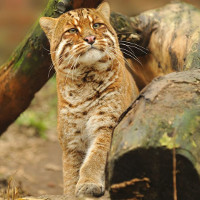 |
Temminck's Cat |
|
He is a wild animal |
Origin |
Southeast Asia | |
Translation |
Francis Vandersteen |
| The possession of this animal is not authorized Royal Decree establishing the list of mammals not kept for production purposes that may be kept (M.B. 24.08.2009) |
| The Temminck's or Asian Golden Cat is a medium-sized feline of the genus Pardofelis. Its coat is generally solid reddish, but many variations exist, including melanistic specimens, spotted like the ocelot or gray; a facial marking composed of white stripes makes it easy to recognize. A discreet inhabitant of the forests of Southeast Asia, its behavior in the wild remains poorly understood due to the small number of scientific studies carried out on this species. A victim of deforestation and poaching for its fur and bones, its numbers in the wild are considered to be in decline. The species is classified as "near-threatened" by the International Union for Conservation of Nature (IUCN). A few dozen Temminck's cats are kept in captivity. The Temminck's Cat is a medium-sized feline, weighing between 9 and 16 kg, or two to three times the weight of a domestic cat. Males are larger than females. The tail represents one-third to one-half of the total length. Length from tip of nose to base of tail is 75 to 105 cm; tail length is 48 to 56 cm. Height at the withers is around 56 cm. Temminck's Cat has only 28 teeth instead of the usual 30. Its distinctive facial markings make it easy to recognize: the eyes are bordered in white, a white stripe surrounded by black crosses each cheek, and a light stripe also bordered in black runs vertically from the inner edge of the eye across the forehead. The small, round ears are black on the back and marked with a gray dot. The coat is generally solid red to golden brown, hence the name "Asian Golden Cat". There is, however, great variability in coat color within the species: it can be gray rather than russet, and there are reports of specimens north of its range with solid spots, like those of the Leopard Cat, or ocelli, in China. A melanistic form also exists. The belly, inner limbs, neck and chin are lighter in color. The last third of the Temminck's tail is darker in color, marked by a white band on the ventral part. The Temminck's Cat prefers to hunt on the ground, although it is capable of climbing trees when necessary. This crepuscular predator preys on small ungulates such as muntjacs or young sambars, birds, large rodents and reptiles. However, it is strong enough to attack larger prey such as the calf of a domestic buffalo, and can also attack small livestock. In Thailand, according to a study carried out on the droppings of medium-sized felines, including the Nebula Panther, Temminck's Cat can attack barking deer, monkeys of the genus Trachypithecus, small Java kanchils, Malayan attherures, ground squirrels and small rodents of the genus Muridae: in frequency, it is mainly small mammals (less than 2.5 kg), particularly Muridae, that make up this feline's "meal". In captivity, Temminck's Cat kills its prey with a bite to the nape of the neck, and feathers birds before eating them. Two specimens studied in Thailand showed a territory size of 47.7 km2 for the male and 32.6 km2 for the female. The male's territory overlaps that of the female, and increases by over 15% during the rainy season. Every day, Temminck's Cat travels an average of 1.6 km, with males moving more than females. The cat's activity is more intense in July than in March. Over the course of a day, Temminck's Cat is most active at dawn and dusk, and most inactive during the late hours of the night. Vocalizations consist essentially of a long, pulsating "maaa", repeated in a series of eight to ten calls uttered at approximately two-second intervals. The first call is generally the quietest, and the sequence may be repeated several times a day, at regular intervals. When in heat, the female may also use this call without repeating it as described above. The Temminck's Cat can also utter a "wa-wa" in close communication, chirp, blow and purr. |






 English (United Kingdom)
English (United Kingdom)